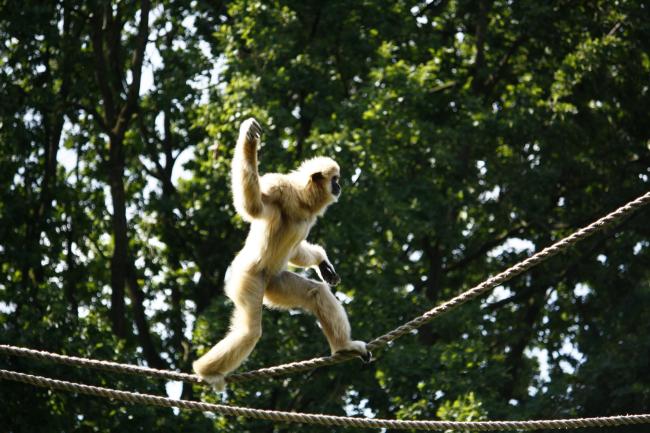Discussion

The aim of the present study was to assess lateralized behavior for both spontaneously occurring as well as for a task-related behavior. In the 15 white-handed gibbons that were observed, significant lateral biases were found at the individual level for several of the spontaneously occurring motor patterns as well as for the more complex tube task. However, no significant side biases were found at the population-level for any of the 15 studied motor patterns.
Previous studies on lateralized behavior in gibbons and other nonhuman primates are often inconsistent in their findings (Fitch & Braccini 2013). Similar to the present study, most studies only report significant hand preferences at the individual level, but not at the population-level (Papademitrou et al. 2005, Meguerditchian et al. 2013). However, some studies have reported significant hand preferences at the population-level for autogrooming (cotton-top tamarins, Diamand & McGrew 1994), scratching (orangutans, Rogers & Kaplan 1996), food reaching (spider monkeys, Laska 1996), bimanual allogrooming (snub-nosed monkeys, Zhao et al. 2010), leading limb (bonobos, Hopkins & de Waal, 1995), and the bimanual tube task (chimpanzees and orangutans, Hopkins et al. 2003).
The large degree of variation between findings of previous studies can often be explained by differences in study design and/or the statistical methods that were used. However, several other factors such as age (Fan et al. 2017), sex (Morino 2011), posture (Olson et al. 1990), captivity (Hopkins et al. 2007), and kinship (Corp & Byrne 2004, Hopkins et al. 2009) have been reported to possibly affect strength and/or direction of lateralized behavior in nonhuman primates.
As the majority of studies on lateralized behavior in nonhuman primated have focused on only one motor pattern, findings on consistency of hand preference across tasks are rare (Lilak & Philips, 2008). However, based on the results from previous studies as well as from the present study, it is likely that nonhuman primates are only consistent in their hand preference across tasks that are similar in the movements that they require (Schweitzer et al. 2007, Motes Rodrigo et al. 2018).
Conclusion
Significant side preferences were found for all behaviors at the individual, but not at the population-level for all 15 observed motor patterns. Similar to other nonhuman primates, the white-handed gibbons in the present study were only consistent in their hand preference across some tasks that required similar movements. Altogether, these findings support the notion that population-level handedness may be restricted to humans.

References*
*The complete list of references is available in the full version of my thesis.
Corp, N., & Byrne, R. W. (2004). Sex Difference in Chimpanzee Handedness. American Journal of Physical Anthropology, 123(1), 62–68.
Diamond, A. C., & McGrew, W. C. (1994). True handedness in the cotton-top tamarin (Saguinus oedipus)? Primates, 35(1), 69–77.
Fan, P., Liu, C., Chen, H., Liu, X., Zhao, D., Zhang, J., & Liu, D. (2017). Preliminary study on hand preference in captive northern white-cheeked gibbons (Nomascus leucogenys). Primates, 58(1), 75–82.
Fitch, W. T., & Braccini, S. N. (2013). Primate laterality and the biology and evolution of human handedness: A review and synthesis. Annals of the New York Academy of Sciences, 1288(1), 70–85.
Hopkins, W. D., & de Waal, F. B. M. (1995). Behavioral laterality in captive bonobos (Pan paniscus): Replication and extension. International Journal of Primatology, 16(2), 261–276.
Hopkins, W. D., Stoinski, T. S., Lukas, K. E., Ross, S. R., & Wesley, M. J. (2003). Comparative Assessment of Handedness for a Coordinated Bimanual Task in Chimpanzees (Pan troglodytes), Gorillas (Gorilla gorilla), and Orangutans (Pongo pygmaeus). Journal of Comparative Psychology, 117(3), 302–308.
Hopkins, W. D., Russell, J. L., Remkus, M., Freeman, H., & Schapiro, S. J. (2007). Handedness and grooming in Pan troglodytes: Comparative analysis between findings in captive and wild individuals. International Journal of Primatology, 28(6), 1315–1326.
Hopkins, W. D., Russell, J. L., Schaeffer, J. A., Gardner, M., & Schapiro, S. J. (2009). Handedness for tool use in captive chimpanzees (Pan troglodytes): Sex differences, performance, heritability and comparison to the wild. Behaviour, 146(11), 1463–1483.
Laska, M. (1996a). Manual laterality in spider monkeys (Ateles geoffroyi) solving visually and tactually guided food-reaching tasks. Cortex, 32(4), 717–726.
Lilak, A. L., & Phillips, K. A. (2008). Consistency of hand preference across low-level and high-level tasks in capuchin monkeys (Cebus apella). American Journal of Primatology, 70(3), 254–260.
Meguerditchian, A., Vauclair, J., & Hopkins, W. D. (2013). On the origins of human handedness and language: A comparative review of hand preferences for bimanual coordinated actions and gestural communication in nonhuman primates. Developmental Psychobiology, 55(6), 637–650.
Morino, L. (2011). Left-hand Preference for a Complex Manual Task in a Population of Wild Siamangs (Symphalangus syndactylus). International Journal of Primatology, 32(3), 793–800.
Motes Rodrigo, A., Ramirez Torres, C. E., Hernandez Salazar, L. T., & Laska, M. (2018). Hand preferences in two unimanual and two bimanual coordinated tasks in the black-handed spider monkey (Ateles geoffroyi). Journal of Comparative Psychology, 132(2), 220–229.
Olson, D. A., Ellis, J. E., & Nadler, R. D. (1990). Hand preferences in captive gorillas, orang‐utans and gibbons. American Journal of Primatology, 20(2), 83–94.
Papademetriou, E., Sheu, C. F., & Michel, G. F. (2005). A meta-analysis of primate hand preferences, particularly for reaching. Journal of Comparative Psychology, 119(1), 33–48.
Rogers, L. J., & Kaplan, G. (1996). Hand preferences and other lateral biases in rehabilitated orang-utans, Pongo pygmaeus pygmaeus. Animal Behaviour, 51(1), 13–25.
Schweitzer, C., Bec, P., & Blois-Heulin, C. (2007). Does the complexity of the task influence manual laterality in De Brazza’s monkeys (Cercopithecus neglectus)? Ethology, 113(10), 983–994.
Zhao, D., Gao, X., & Li, B. (2010). Hand preference for spontaneously unimanual and bimanual coordinated tasks in wild Sichuan snub-nosed monkeys: Implication for hemispheric specialization. Behavioural Brain Research, 208(1), 85–89.
Responsible for this page:
Director of undergraduate studies Biology
Last updated:
05/18/21
